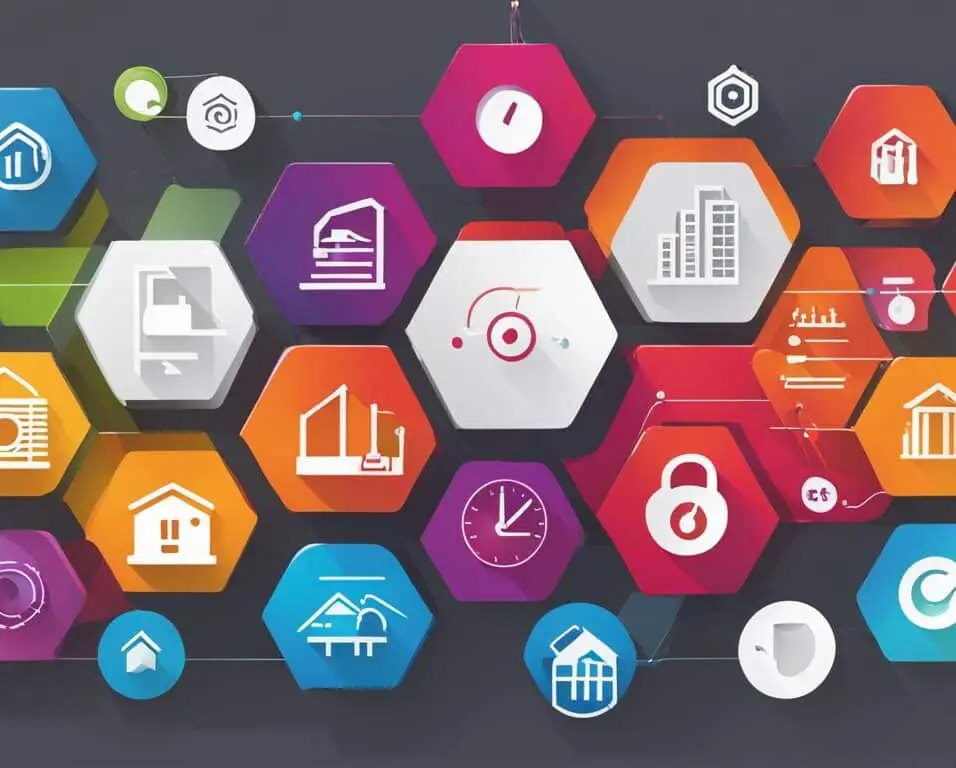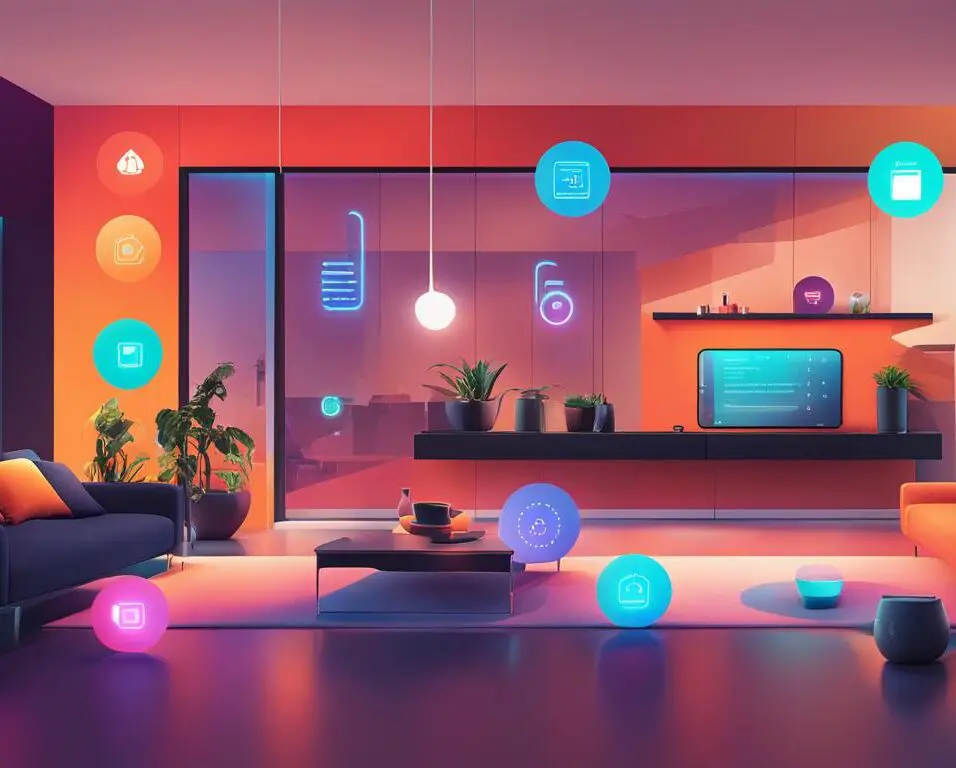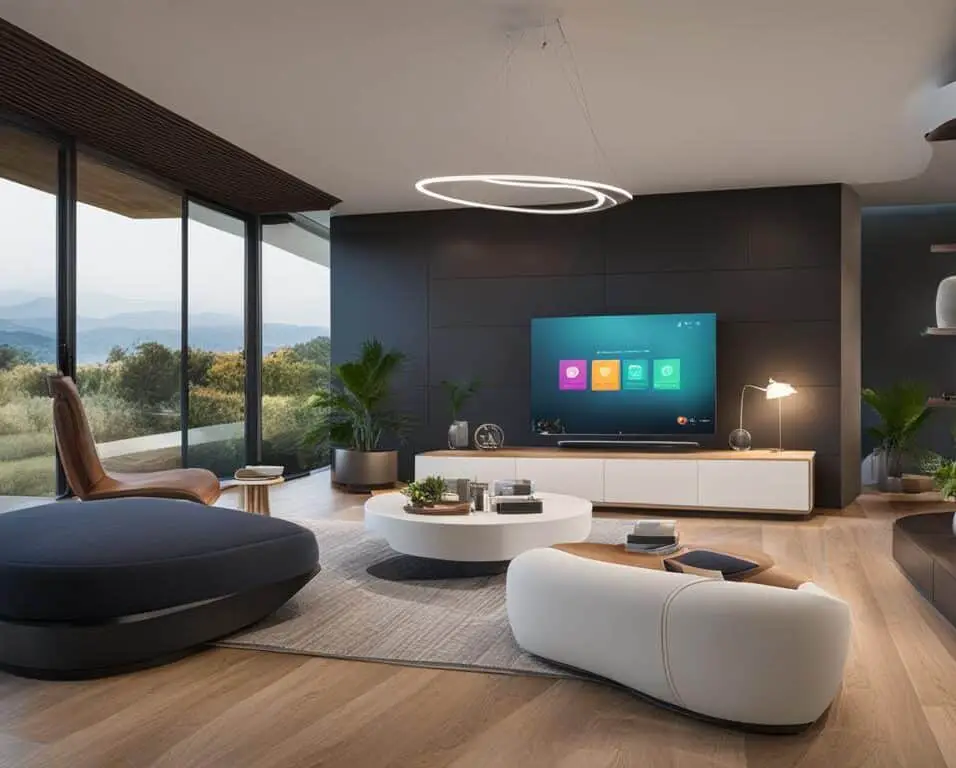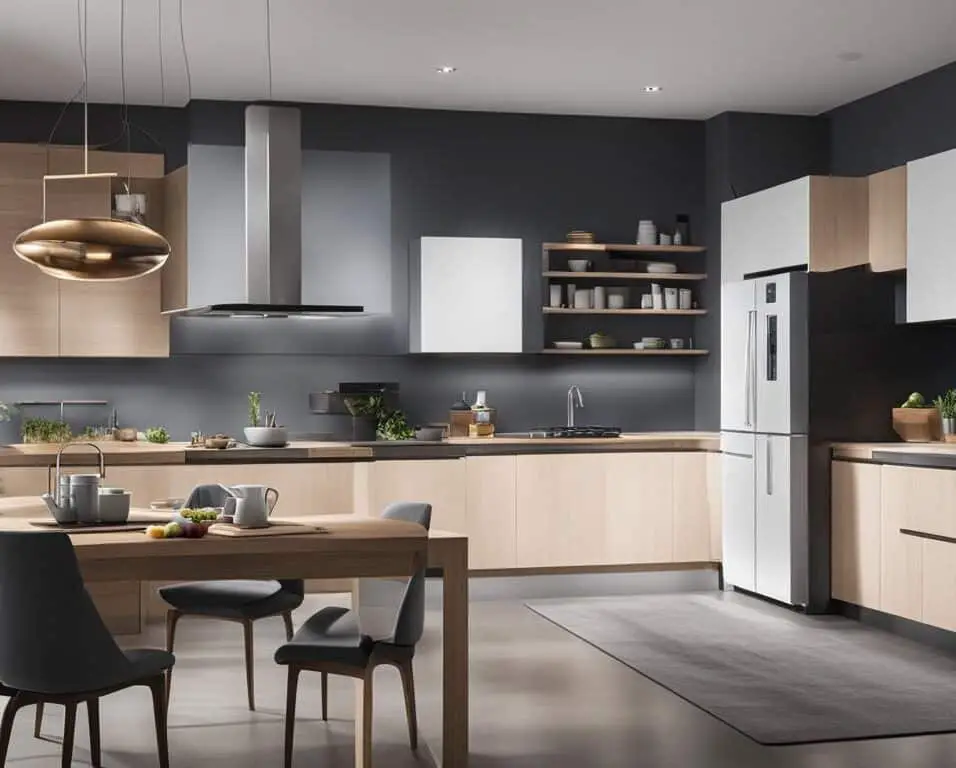IoT-Driven Efficiency in Home Technology
The Internet of Things (IoT) has transformed the way we optimize energy usage and efficiency in our homes. By integrating IoT devices into our smart homes, we can achieve greater control, monitoring, and integration of renewable energy sources, paving the way for efficient and sustainable living.
With IoT integration, homeowners can experience the benefits of automated control, energy monitoring, and seamless integration of renewable energy sources like solar panels. This not only allows for optimized energy usage but also helps in reducing waste and saving on energy bills.
In addition to the benefits at the individual homeowner level, IoT-enabled smart grids offer real-time monitoring, demand response capabilities, and energy distribution optimization. By seamlessly integrating decentralized energy sources like rooftop solar panels and electric vehicle batteries, smart grids enhance energy efficiency and contribute to a more reliable and resilient energy infrastructure.
Embracing IoT-driven energy efficiency in our homes not only leads to cost savings but also promotes sustainability and reduces our carbon footprint. It is a stepping stone towards a greener future and a more connected living experience.
Key Takeaways:
- Integration of IoT devices in smart homes enables automated control and energy monitoring.
- IoT integration allows for the seamless integration of renewable energy sources like solar panels.
- Smart grids powered by IoT offer real-time monitoring and optimization of energy distribution.
- Embracing IoT-driven energy efficiency leads to cost savings and sustainability.
- IoT-driven smart homes contribute to a more connected and efficient living experience.
The Power of Smart Homes
Smart homes are at the forefront of home automation, providing homeowners with an array of exciting benefits. With the integration of Internet of Things (IoT) devices, homeowners gain automated control over various household devices, resulting in enhanced convenience and efficiency. Let’s delve into three key aspects that highlight the power of smart homes:
1. Home Automation
Through IoT devices, smart homes offer automated control over lights, thermostats, appliances, and more. This seamless integration allows homeowners to effortlessly manage their living spaces, creating an environment tailored to their preferences. Whether it’s adjusting lighting to create the perfect ambiance or controlling the temperature for optimal comfort, home automation simplifies daily routines and enhances quality of life.
2. Energy Monitoring
The ability to monitor energy consumption is a valuable feature of smart homes. IoT-enabled smart meters and energy management systems allow homeowners to track and analyze their energy usage patterns. This real-time data empowers individuals to make informed decisions about their energy consumption and identify opportunities for optimization. By understanding their energy usage, homeowners can implement strategies to reduce waste, lower energy bills, and contribute to a more sustainable future.
3. Renewable Energy Integration
Smart homes facilitate the integration of renewable energy sources, such as solar panels and wind turbines. By harnessing the power of these clean energy solutions, homeowners can enhance energy efficiency and reduce dependency on traditional energy sources. Smart homes equipped with renewable energy integration not only benefit the environment but also offer long-term cost savings.
“Integrating IoT devices in smart homes revolutionizes daily living, providing unparalleled convenience, energy efficiency, and sustainability.” – [Author Name]
The power of smart homes lies in their ability to seamlessly integrate IoT devices, enabling home automation, energy monitoring, and renewable energy integration. Together, these features create a truly connected and efficient living experience, transforming the way we interact with our homes.
| Benefits of Smart Homes | Examples |
|---|---|
| Convenience | Controlling household devices remotely through mobile apps or voice commands |
| Energy Efficiency | Automated control of lights, thermostats, and appliances for optimized energy usage |
| Enhanced Security | Remote monitoring, smart locks, and video surveillance systems |
As the adoption of smart home technology continues to grow, homeowners can expect even more advancements in IoT-driven solutions. From AI integration to energy optimization and expanded interconnectivity, the future of smart homes holds limitless possibilities.
Revolutionizing the Energy Grid with IoT
The integration of IoT technology in energy grids is transforming the way we monitor, respond to demand, optimize energy distribution, and incorporate decentralized energy sources. IoT-enabled smart grids offer a host of benefits that enhance energy efficiency, sustainability, and grid resilience.
Real-Time Grid Monitoring
Grid monitoring plays a crucial role in ensuring the reliable and efficient delivery of electricity. With IoT, real-time monitoring of the power grid becomes a reality. Sensor-equipped devices and advanced analytics provide valuable insights into grid performance, allowing for proactive measures to address issues like grid congestion, voltage fluctuations, and outages. By continuously monitoring the grid, utilities can make informed decisions and take timely actions to maintain grid stability.
Demand Response Programs
IoT-enabled smart grids empower utilities to implement demand response programs, which incentivize customers to reduce their energy consumption during peak periods. Through automated communication systems, smart meters, and IoT-enabled devices, utilities can send signals to participating customers, encouraging them to adjust their energy usage. This helps to balance the demand for electricity, alleviate strain on the grid, and avoid potential service disruptions.
Optimized Energy Distribution
Efficient energy distribution is crucial for maximizing grid performance and ensuring that electricity reaches end consumers without loss. IoT technology enables utilities to optimize energy distribution by monitoring and analyzing energy flows, identifying areas of inefficiency, and making real-time adjustments. By leveraging IoT-enabled devices and data analytics, utilities can minimize transmission losses and enhance overall energy distribution efficiency.
Integration of Decentralized Energy Sources
The proliferation of decentralized energy sources, such as rooftop solar panels and electric vehicle (EV) batteries, presents both opportunities and challenges for energy grids. IoT plays a pivotal role in seamlessly integrating these decentralized energy sources into the grid. Through intelligent monitoring, control, and coordination, IoT-enabled systems ensure the efficient utilization of renewable energy generated by these distributed sources. This not only reduces reliance on traditional energy sources but also contributes to a greener and more sustainable energy landscape.
Overall, the integration of IoT technology into energy grids revolutionizes grid monitoring, demand response programs, energy distribution optimization, and the integration of decentralized energy sources. By harnessing the power of IoT, utilities can enhance energy efficiency, reduce costs, and pave the way for a more sustainable energy future.
The Benefits of IoT-Driven Energy Efficiency
Embracing IoT-driven energy efficiency brings a host of advantages for both homeowners and the environment. Through the integration of IoT technology, households can achieve reduced energy waste, increased energy conservation, and substantial cost savings on energy bills. Studies have shown that implementing IoT solutions can result in savings of up to 15-30% on household energy expenses.
Energy conservation lies at the core of IoT-driven efficiency initiatives. By leveraging smart devices and systems, homeowners can optimize energy usage and avoid unnecessary waste. Whether it’s automatically adjusting thermostats based on occupancy or remotely controlling appliances to minimize standby power, IoT enables precise control over energy consumption, leading to significant conservation.
The cost savings associated with IoT-driven energy efficiency extend beyond the direct reduction in energy bills. By actively monitoring and managing energy usage, homeowners can identify areas of inefficiency and make informed decisions to reduce energy waste. This proactive approach not only saves money but also contributes to a more sustainable future by reducing overall energy demand.
“Implementing IoT-driven energy efficiency solutions can lead to cost savings of up to 30%, making it a wise investment for homeowners.”
Besides cost savings, embracing IoT-driven energy efficiency contributes to sustainability and environmental preservation. By reducing energy waste and optimizing consumption, IoT integration lowers carbon emissions and helps mitigate the impacts of climate change. It also enables homeowners to integrate renewable energy sources, such as solar panels, into their smart homes, further promoting sustainable and clean energy practices.
IoT-driven smart grids play a crucial role in enhancing grid resilience. By facilitating real-time monitoring and early fault detection, smart grids can minimize downtime and enable rapid response to disruptions. This resilience ensures a reliable energy supply, even in times of extreme weather events or system failures. The integration of decentralized energy sources, such as residential solar panels, enhances grid resilience and promotes more distributed and sustainable energy systems.
To summarize, adopting IoT-driven energy efficiency solutions empowers homeowners to achieve energy conservation, cost savings, and sustainability while contributing to the resilience of the energy grid. By optimizing energy usage, reducing waste, and embracing renewable resources, IoT-enabled smart homes pave the way for a greener and more efficient future.

Maximizing Efficiency: How the Internet of Things Revolutionizes Smart Homes
The Internet of Things (IoT) empowers smart homes with interconnected devices, transforming the way we live. Through IoT integration, homeowners can unlock the potential of remote accessibility, energy efficiency, and enhanced security in their homes.
Interconnected Devices for Seamless Control
IoT enables the seamless interconnectivity of various devices within a smart home ecosystem. From lights to thermostats, appliances to entertainment systems, all can be interconnected, allowing for centralized control. With a simple tap on a mobile app or a voice command, homeowners can effortlessly manage their devices, creating a personalized and convenient living experience.
Remote Accessibility for Seamless Living
The beauty of IoT lies in its ability to provide remote accessibility. Through mobile apps or voice assistants like Amazon Alexa or Google Assistant, homeowners can remotely access and control their smart devices from anywhere in the world. Forgot to turn off the lights? Is the thermostat set too high? With IoT, these concerns can be addressed in an instant, saving time, energy, and maintaining optimal comfort levels.
Energy Efficiency for Sustainable Living
One of the key benefits of IoT in smart homes is its ability to enhance energy efficiency. With IoT-enabled energy monitoring systems, homeowners can track and manage their energy consumption in real-time, identifying areas where energy waste can be minimized. IoT integration also facilitates automated control, allowing devices to adjust their energy usage based on occupancy and environmental conditions. This optimization not only reduces energy consumption but also leads to significant cost savings on energy bills.
Enhanced Security for Peace of Mind
IoT brings enhanced security features to smart homes for added peace of mind. Remote monitoring systems enable homeowners to keep an eye on their property, inside and out, through video surveillance and smart security cameras. Access control through smart locks provides convenient and secure entry, while real-time alerts notify homeowners of any suspicious activities. With IoT, smart homes become a fortress of security, protecting both property and loved ones.
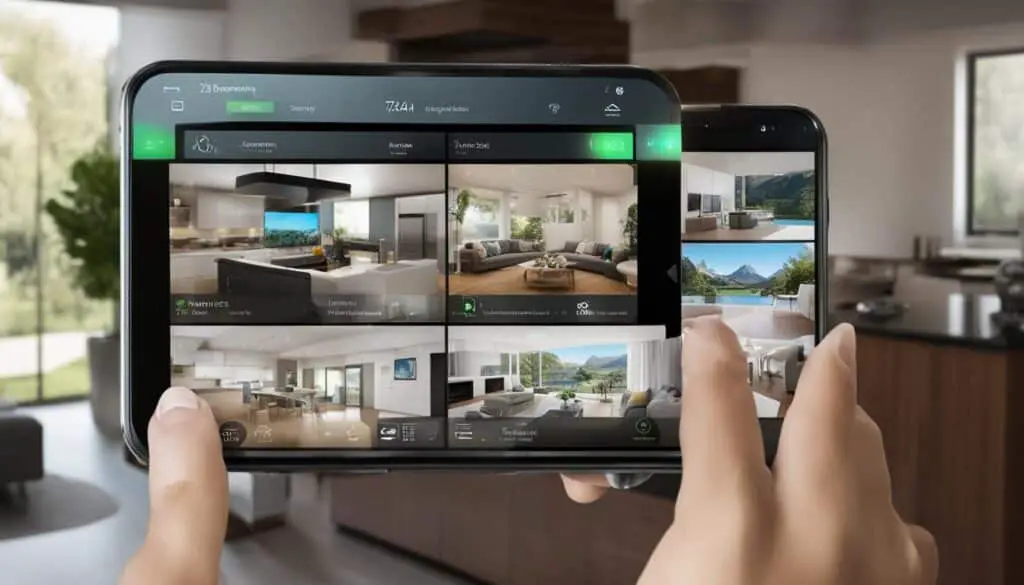
In conclusion, the Internet of Things revolutionizes smart homes by maximizing efficiency through interconnected devices, remote accessibility, energy efficiency, and enhanced security. The seamless integration of IoT technologies into homes ensures a connected, sustainable, and secure living experience for homeowners.
Conclusion
The IoT revolution is reshaping the landscape of energy efficiency in smart homes, ushering in a new era of convenience, energy savings, and enhanced security. By harnessing the power of interconnected devices and real-time data, homeowners can optimize their energy usage and reduce waste, resulting in significant benefits for both their wallets and the environment.
The future of smart homes and IoT integration holds even greater potential for innovation and improvement. As AI technology continues to advance, we can expect seamless integration of artificial intelligence into our smart homes, enabling personalized energy optimization and intuitive automation. This will further enhance the efficiency and convenience of our living spaces.
Moreover, the expanding interconnectivity facilitated by IoT opens up a world of possibilities for smart homes. With interconnected devices seamlessly communicating with each other, homeowners can enjoy the luxury of remote control and access to their home systems, whether it’s adjusting the thermostat on the way back from work or monitoring security cameras while on vacation.
Embracing the transformative power of IoT in smart homes paves the way for a more efficient, sustainable, and connected living experience. By staying at the forefront of the IoT revolution and leveraging the potential it offers, homeowners can not only enjoy the benefits of energy savings and convenience today but also contribute to a greener and more sustainable future for all.
FAQ
How does integrating IoT devices enhance energy efficiency in smart homes?
Integrating IoT devices allows for automated control of household devices, energy monitoring through smart meters, and integration of renewable energy sources like solar panels. This optimization leads to reduced energy waste and increased energy efficiency in smart homes.
What are the benefits of IoT-driven energy efficiency in smart grids?
IoT-driven energy efficiency in smart grids offers real-time monitoring, demand response capabilities, energy distribution optimization, and seamless integration of decentralized energy sources. These benefits contribute to energy conservation, cost savings, and improved grid resilience.
How can IoT revolutionize energy efficiency in smart homes?
IoT enhances energy efficiency in smart homes through features like automated control, energy monitoring, remote accessibility, and integrated systems. With interconnected devices and real-time data, homeowners can optimize energy usage, reduce waste, and enhance security.
What are the cost savings potential of IoT-driven energy efficiency?
Embracing IoT-driven energy efficiency in smart homes can lead to cost savings of up to 15-30% on household energy bills. By optimizing energy usage and integrating renewable energy sources, homeowners can reduce their energy expenses.
How does IoT integration contribute to sustainability?
IoT integration in smart homes and grids lowers carbon emissions, mitigates climate change impacts, and promotes sustainability. By optimizing energy usage, integrating renewables, and reducing energy waste, IoT-driven energy efficiency contributes to a greener future.
What are the security benefits of IoT in smart homes?
IoT enhances home security in smart homes through features like remote monitoring, smart locks, and video surveillance systems. The interconnected devices and remote accessibility provided by IoT technology enhance overall security and peace of mind.
What does the future hold for IoT integration in smart homes?
The future of smart homes and IoT integration holds exciting possibilities such as AI integration, energy optimization, and expanded interconnectivity. Embracing the power of IoT in smart homes paves the way for a more efficient, sustainable, and connected living experience.




